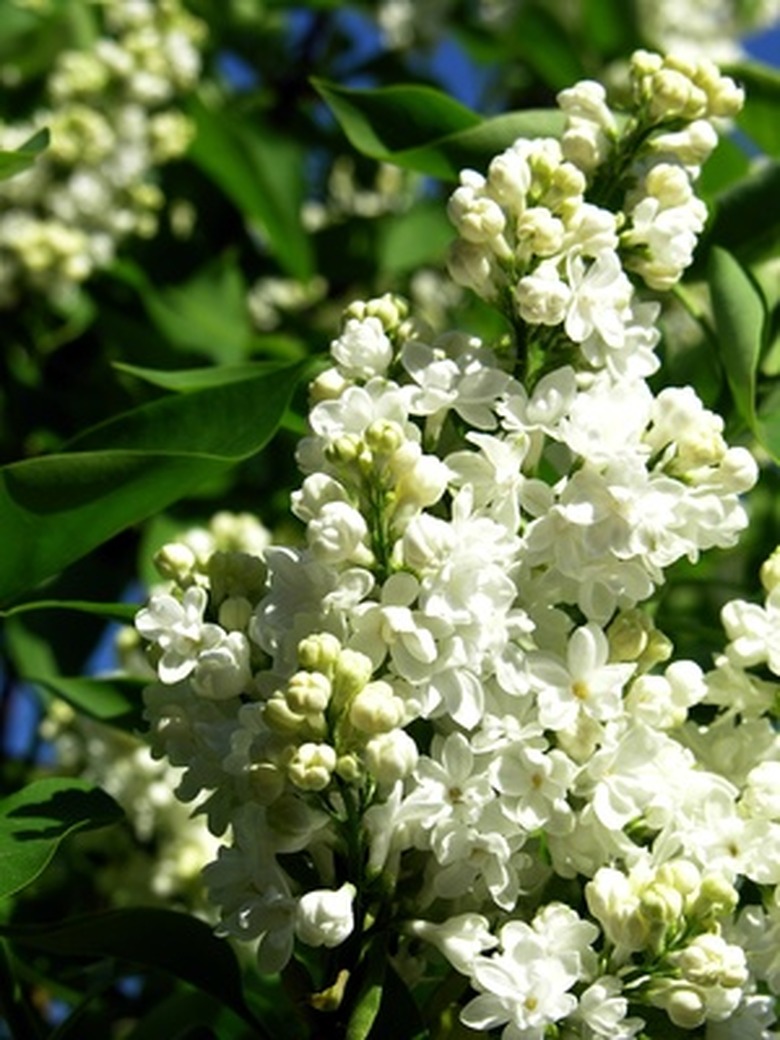Varieties Of Lilac Trees
Producing white flowers in late May, June or July on a tree growing 20 to 30 feet tall and 15 to 25 feet wide, the Japanese tree lilac (Syringa reticulata) is regarded as a tough, virtually disease-free plant: a true lilac tree. Resistant to mildew, scale and borers, it even grows well in windy locations, nutrient-poor and alkaline soils. Grow this deciduous tree in USDA Hardiness Zones 3 through 7.
Ivory Silk
Often considered as the variety of choice, Ivory Silk begins flowering when the tree is only 5 feet tall. It matures to a size slightly smaller than the species, at 25 feet in height and 20 feet wide. The abundant production of white flowers in early to midsummer outpaces that of the species, too. Its glossy brown bark covers rather stocky branches, adding to its ornamental qualities in the winter with leaves absent. This selection was first introduced by the Sheridan Nursery in Ontario, Canada.
- Producing white flowers in late May, June or July on a tree growing 20 to 30 feet tall and 15 to 25 feet wide, the Japanese tree lilac (Syringa reticulata) is regarded as a tough, virtually disease-free plant: a true lilac tree.
Regent
The variety Regent was introduced by Princeton University in Princeton, New Jersey. It grows vigorously and produces abundant white flower clusters in summer. Regent's canopy grows more narrowly than other Japanese tree lilac selections, making it a good choice for urban street tree use. At maturity, expect Regent to be 25 to 30 feet tall and 15 feet wide.
Summer Snow
In contrast to the narrower Regent, Summer Snow develops a compact, rounder leaf canopy with a mature height of 25 feet and spread of 20 feet. This uniform shape favors use as a park or yard tree, resembling a cherry tree's stature and bark. It also works well as a street tree.
- The variety Regent was introduced by Princeton University in Princeton, New Jersey.
- This uniform shape favors use as a park or yard tree, resembling a cherry tree's stature and bark.
Chantilly Lace
If sited out of hot, intense afternoon sunlight, expect the variegated leaves of Chantilly Lace to look their best. The glossy green leaves emerge in spring with creamy green-yellow edges and slowly fade to pale cream. The ivory colored flowers by midsummer remains the seasonal show-stopper, but the foliage coloration remains interesting into autumn even though they do not change colors before dropping. This variety grows to 25 feet tall and wide and first discovered by John Herrmann of Limehouse, Ontario around 1980.
Cameo Jewel
The foliage of Cameo Jewel, sometimes called Cameo's Jewel, has a blotched deep and medium green center and an irregular edging of light yellow. By midsummer, when the flowers appear, leaf edges become a paler yellow to cream.
China Gold
This unusual selection resulted after seeds were treated with colchicine in 1955. China Gold's foliage emerges pale yellow and becomes more green-yellow as the growing season ages. New branch twigs bear a reddish tint. It produces the typical ivory colored flowers in summertime and grows to a height of 25 feet with a width of 20 to 25 feet.
- If sited out of hot, intense afternoon sunlight, expect the variegated leaves of Chantilly Lace to look their best.
- The ivory colored flowers by midsummer remains the seasonal show-stopper, but the foliage coloration remains interesting into autumn even though they do not change colors before dropping.
Elliott
Sold under the trademark name of Snow Cap™, this variety grows more compact than the industry standard Ivory Silk, reaching 15 to 20 feet high by only 10 to 12 feet wide. It bears thick, dark green leaves and plentiful white flower spikes in summer. The uniform branching habit makes this a great small tree for urban settings. This variety also grows well in milder USDA Zone 8.
Willamette
Released by Carlton Plant Nursery in 2000, Willamette is more commonly marketed by the name Ivory Pillar™. White flowers adorn the tree in summer, but what sets this selection apart is the pyramid-like shape of its canopy, maturing to a height of 25 to 30 feet and tapering width of 15 to 20 feet.
Snow Dance
Honey-scented white flowers decorate the canopy of this selection, which reaches 25 to 35 feet at maturity. Snow Dance typically blooms heavily each year, unlike Ivory Silk which may produce heavier flowering displays in alternate years.
- Sold under the trademark name of Snow Cap™, this variety grows more compact than the industry standard Ivory Silk, reaching 15 to 20 feet high by only 10 to 12 feet wide.
Sigzam
No one uses the registered variety name Sigzam, but rather the trademark name of Signature™ for this variety. The flower clusters attain a more oval clustered shape and appear one to two weeks later than other Japanese tree lilac varieties. This compact tree grows about 20 to 25 tall and wide. It may also be grown in USDA Zone 8.
References
- "Dirr's Hardy Trees and Shrubs"; Michael A. Dirr; 1997
- The Ohio State University: Syringa reticulata
